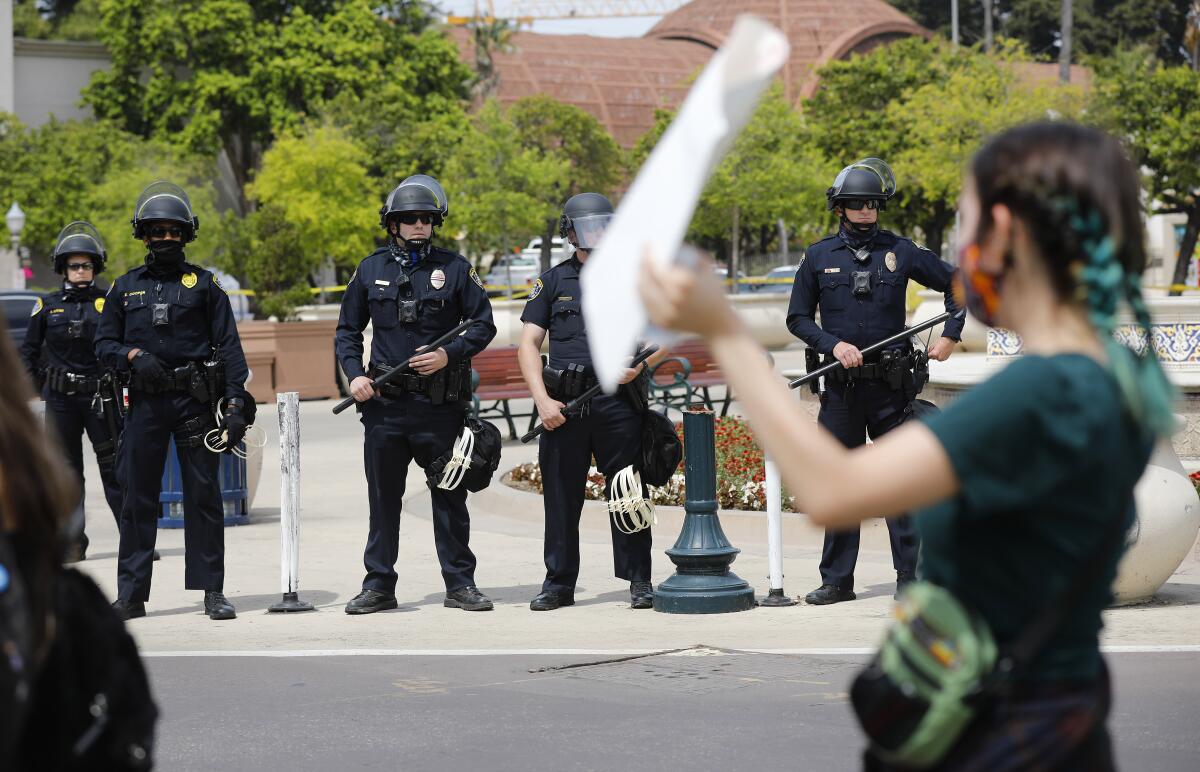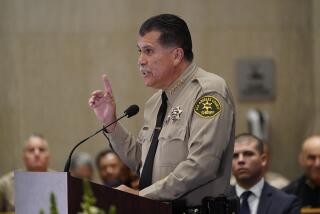New policy on protests outlines when San Diego police should use less-lethal weapons, deem events unlawful

- Share via
SAN DIEGO — The San Diego Police Department this week implemented a policy that sets parameters on officers’ actions during demonstrations, from when they give dispersal orders during protests deemed unlawful to when they fire less-lethal rounds.
The policy, in the works for several months, came about in the aftermath of last year’s recurring protests against police violence in San Diego and across the country.
For the record:
1:11 p.m. Feb. 21, 2021This story previously misstated the time a Commission on Police Practices committee will meet. It is scheduled for 4:30 p.m. Thursday.
Some protesters in San Diego have decried the way police responded to the protests — at times in tactical gear and large numbers, and with force. Meanwhile, San Diego police officials have described some of the protesters as unruly, saying some threw rocks and bottles at officers on the front lines.
The new policy was unveiled Thursday when the Police Department uploaded to its website the 15-page document. Some community members, unaware of the news before a Union-Tribune reporter asked for comment, criticized the policy. They said it fails to emphasize de-escalation and address bias-based policing, among other concerns.
A police spokesman said department leaders were not available to discuss the policy. The San Diego Police Officers Assn.’s president said he is satisfied with it.
“It is essential because it carefully spells out our officers’ role in all types of 1st Amendment activity, from peaceful assemblies through full-out riots,” Jack Schaeffer said. He added that the policy helps the public understand how police respond to demonstrations.
The effort began with the now defunct Community Review Board on Police Practices, which researched policies in other cities and shared them with the Police Department to offer guidance. The policy is similar to one put in place by the Oakland Police Department.
San Diego’s policy states that the department supports peaceful demonstrations. The department’s goal, the policy says, is to ensure demonstrations stay peaceful, prevent criminal activities, control traffic and “facilitate the safe exercise of an individual or group’s First Amendment rights.”
The policy assigns several key duties to a designated incident commander, beginning with the development of a contingency plan. To determine the appropriate resources and level of preparedness, the incident commander should consider factors including the composition of the group that is expected to turn out and the size, time and location of the demonstration. Other considerations include whether arrests or unlawful acts, including riots, are “planned or likely.”
Regardless of the opinions expressed the day of a protest, officers must act in a professional and courteous manner, as per the policy.
With approval from the incident commander, officers may replace their name tags with a tag that displays their four-digit, department-issued ID number. The move was previously implemented under a department order, which drew criticism from some community members who said it undermined transparency and accountability.
During a demonstration, the policy notes, officers may encounter individuals who engage in criminal activities that don’t reflect the larger crowd. In those instances, if feasible, officers must address the crimes with little disruption to the demonstration.
Unlawful assemblies
It is up to the incident commander to decide whether to declare a demonstration unlawful under state law. The incident commander must consider factors including the number and nature of unlawful acts, the threats to people or property and whether arrests would be more appropriate than forcing the crowd to disperse.
If the demonstration is deemed unlawful, the policy requires at least three dispersal orders, in Spanish and English. An officer must make the announcements through equipment such as a bullhorn or public announcement system. Crowds must be given “ample means of egress” and “reasonable time” to comply, the policy states.
Before the orders are announced, officers must turn on their body-worn cameras.
If demonstrators don’t comply, the incident commander may give officers the green light to turn to what the policy calls “dispersal techniques,” which include coordinated efforts to contain and move into a crowd to make arrests.
Also listed under “dispersal techniques” are what the policy calls specialty weapons, which include firing less-lethal rounds. The policy states that the incident commander must coordinate the use of pepper spray, foam and pepperball rounds, and flashbang grenades. It is up to an assistant chief to authorize the use of tear gas grenades and rubber sting balls — grenades that fire small pellets and cause a loud blast and bright flash. Only a SWAT team leader may use tear gas grenades or rubber sting balls.
Even when officers turn to “dispersal techniques,” the policy requires them to try to gain compliance “through announcements and negotiation,” and the incident commander must suspend the use of “dispersal techniques” once the demonstrators spread apart from one another or start to leave the area.
If those same demonstrators gather again at a different location, police cannot disperse the crowd so long as the gathering is not unlawful.
The policy states that officers must not direct dispersal orders or “enforcement action” toward the media, adding that “clearly identified media shall be permitted to carry out their professional duties unless their presence would unduly interfere with the enforcement action.”
Community response
Some community members said they were concerned with what they viewed as a lack of restrictions on the use of less-lethal weapons and a focus on de-escalation.
“The concept of de-escalation ought to be baked into this from beginning to end,” said David Loy, legal director of the American Civil Liberties Union of San Diego and Imperial Counties.
He said less-lethal weapons should be a “last resort,” if not off the table. He said the policy gives a lot of discretion to the incident commander — which he called problematic because he has seen police resort to less-lethal weapons quickly.
Others, including KC Short, president of the nonprofit We Stand United San Diego, said the use of less-lethal weapons escalate situations.
Kylee Belanger, director of the San Diego National Lawyers Guild Legal Observer Program, said she believes the policy’s intent is to “chill free speech.” She said the policy hurts not just the public but also the media and front-line officers because force against a crowd puts them in danger, too.
On the topic of unlawful assemblies, Loy said the policy leaves open to loose interpretation the level of threat to property that police would consider grounds to declare a demonstration unlawful. He questioned whether minor vandalism would cause police to declare a demonstration unlawful. While the policy quotes the definition of an unlawful assembly under state law, Loy added that case law has determined there must be “clear and present danger of imminent violence” for a a demonstration to be unlawful.
He also raised concerns about considering the composition of a group of demonstrators in the planning stage. That consideration gets at the identity of the group and their message, and police shouldn’t consider those factors, he said.
Geneviéve Jones-Wright, executive director of Community Advocates for Just and Moral Governance, said a staff attorney had concerns about police trying to work with organizers because they don’t have authority over demonstrators and could be scapegoated if things go wrong.
She added that the policy lacks “real safeguards” against bias in deeming demonstrations unlawful and language to prevent officers from “barricading” protesters while simultaneously telling crowds to disperse.
Activist Tasha Williamson said she believes there will be no accountability for any policy violations. She said it is hard to take serious a department that has engaged in bias-based policing and allows its officers to swap out their name tags for tag with an ID number instead.
Asked to respond to concerns that the policy doesn’t do enough to limit use of less-lethal weapons, emphasize de-escalation or prevent biased-based policing, Schaeffer, the police union president, said he doubts some critics will ever be fully satisfied with “any reasonable response.”
“It is of utmost concern that we can maintain San Diego residents’ safety while using only appropriate levels of force, if any,” he said in an email. “I believe this policy addresses all those issues.”
Brandon Hilpert, chair of the Commission on Police Practices, called the policy “a great start” and added that he wants clarification on parts of the policy. The commission, which previously operated as the Community Review Board on Police Practices, will review the document and make any necessary recommendations, he said. A subcommittee is expected to discuss the policy Thursday during a virtual meeting set for 4 p.m.
More to Read
Sign up for Essential California
The most important California stories and recommendations in your inbox every morning.
You may occasionally receive promotional content from the Los Angeles Times.










